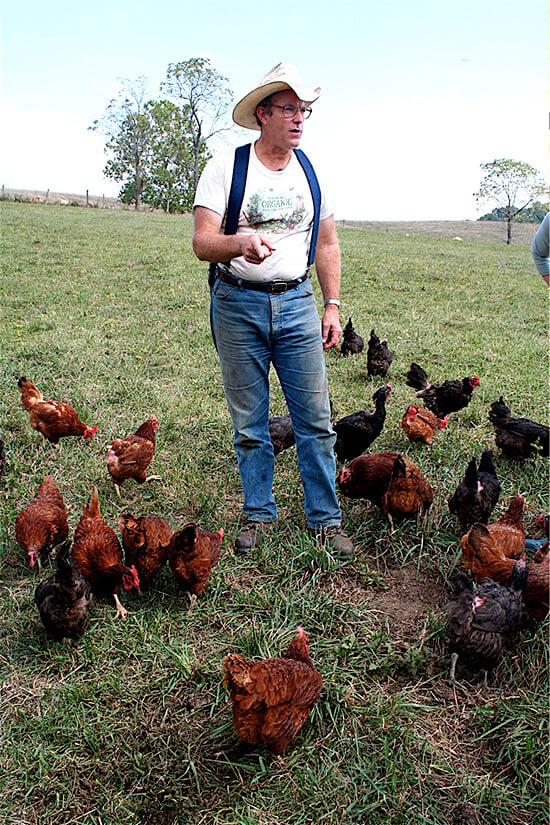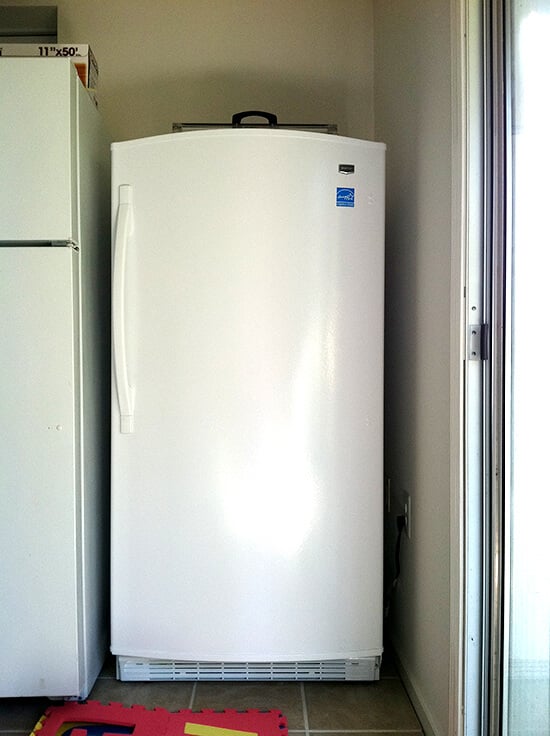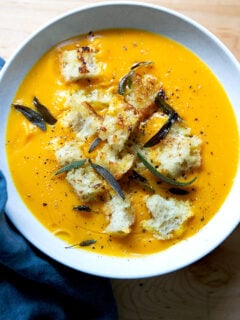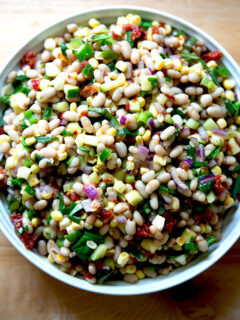On Eating Locally
This post may contain affiliate links. Please read my disclosure policy.

Someone once described it to me as the “gateway drug.” I can’t think of a more perfect description. It certainly leads to all sorts of addictive behavior. Those of you who have read Michael Pollan’s The Omnivore’s Dilemma likely can relate.
If you haven’t yet read it, be warned: You might find yourself tearing around obsessively seeking out vendors selling grass-fed beef, questioning the meaning of the “free-range, organic” label on grocery-store chicken, eyeing the pristine January produce more skeptically, and accepting (within reason) the higher price of anything sold at farmers’ markets.
You might even be inspired to visit Polyface Farm in Swoope, Virginia, where Pollan spent a week learning about grass farming from the legendary Joel Salatin. This is what happened to me.
So in the fall of 2007, my husband and I trekked out to the Shenandoah Valley intending to wander around Polyface Farm for a few hours, an activity Salatin invites everyone to do — transparency is one of the farm’s underlying tenets: anyone can visit the farm to observe Salatin’s farming methods and to see how his animals live. But when our arrival coincided with a group from Washington DC, who had scheduled a guided visit of Polyface, Salatin kindly invited us to tag along. Never have I felt the stars aligned more for me. It was a memorable day to say the least. Salatin (pictured above with his chickens) is as engaging, funny, and knowledgeable as Pollan describes.
If you care to read more about the “olive oil pork” and “salad-bar beef” produced on the extraordinarily productive Polyface Farm powered by the sun along with a few mobile devices — eggmobiles, gobbledygos, shademobiles, to name a few — do so here. And view the slideshow from our visit here.
The Omnivore’s Dilemma was the gateway drug for me. Within a week of reading it, I had joined a CSA and had become a regular at several Philadelphia farmers’ markets. Reading Terminal Market and the Fair Food Farmstand, in particular, became my go-to sources for humanely-raised meat and dairy products. I began cooking more seasonally and began enjoying vegetables in their most pure state often with nothing more than a drizzling of olive oil and a pinch of salt.
With an incredible farm-to-city network in place, Philadelphia made it it easy to eat locally. We haven’t been as lucky in the places we have lived since. Today, the closest farmers’ market for us happens once a week 20 miles away, and shops selling humanely raised meat and dairy products are nonexistent. It took some time adjusting to our new shopping options, but by tapping into some non-traditional food suppliers, we have been able to find sources for local fruits and vegetables as well as humanely raised meat.
For those of you finding yourself with limited options for local foods, know that eating locally can be done, but it might take some effort. I’ve listed some tips/resources below.
1. Join a CSA. If you don’t have access to a regular farmers’ market, a CSA is a nice way to add incredibly tasty, fresh, often organic veggies to your diet. CSA stands for Community Supported Agriculture. The term CSA describes a relationship between a farm and the local people who consume the farm’s food. Modeled after a producer-consumer alliance practiced in Switzerland, the first CSA was created in 1986 in Massachusetts. Today over 4000 farms throughout the country participate in this mutually beneficial partnership.
By participating in a CSA, a community member essentially buys a share of a farm’s harvest before the season begins, understanding that unpredictable conditions such as weather and labor supply can effect the harvest. The security of a contract eliminates the need for farmers to invest time marketing their produce during the busy growing season, enabling them to concentrate solely on producing food. In exchange, participating families receive the highest quality produce, often organically grown, and always picked at the peak of its ripeness.
I have now participated in CSAs in eastern Pennsylvania, southern California and northern Virginia and cannot say enough about them. When we have CSA produce on hand, I find myself reaching into the fridge, pulling out giant mustard greens, and munching on them raw. The greens, in my opinion, are the highlight of the CSA.
Joining a CSA, moreover, is more cost effective in my experience than shopping at farmers’ markets. Prices vary but CSA prices often are on par with grocery store prices. Local Harvest is a great source for finding a CSA near you.
Also note that it’s definitely an adjustment joining a CSA. You have to be willing to try new vegetables, and you have to strategize, too — some veggies wither away faster than others, and nearly all CSA produce withers faster than grocery store produce. It makes you wonder, right? And don’t despair, you won’t be the first to allow the odd radish or kohlrabi bulb to desiccate in your fridge.
These two books have been invaluable to me as far as knowing what to do with some of my CSA vegetables:
Alice Waters’ Chez Panisse Vegetables
Sally Schneider’s A New Way To Cook
2. Buy a free-standing freezer, then buy a cow. Or a pig. Or a goat. Or whatever you like or have access to. When Ben and I discovered we had no market nearby selling grass-fed beef, we decided to join a “cowpool” and purchased from a local farm a half cow (a steer, actually), which we then split with four families. The price per pound of our meat came out to be $3.30, which is very low for grass-fed meat.
These two sources might help you find a “cowpooling” service near you:
Eat Well GuideEat Wild
But before you buy the cow, buy the freezer. We bought this one.
3. Befriend a hunter. Or marry one. Or start hunting yourself. Ben started hunting this past winter, and as a result, we enjoyed venison and duck all winter long. It was such a treat having incredibly tasty, grass-fed meat on hand. Moreover, with the exception of the butchering cost, the meat was free. I hope one day in the not too distant future, I find myself hunting, too. I have been particularly inspired by Georgia Pelligrini, also known as, Girl Hunter.
4. Start composting; then plant a garden. I have no idea what I’m doing when it comes to composting. But I do compost. Throughout the day I collect my banana peels, egg shells, coffee grounds, vegetable trimmings — any non-meat waste product — into a bowl, and every evening I dump it in our “back porch compostumbler.” (See photo below.) I definitely do not provide the tumbler with the proper ratio of carbonous to nitrogenous materials, but somehow, every month or so, my waste — 90% egg shells and coffee grounds as far as I can tell — turns into a substance resembling compost. (Again, see photo below). Please don’t take my advice when it comes to composting, however. I know there are better systems out there. This is just what we do, and it works for us. The compost tumbler does not attract animals and does not take up too much space, which we appreciate at the moment. Moreover, when we are composting, we use up fewer trash bags, which always feels good.
Composting is especially practical if you garden. I do not have a green thumb but I have had small successes with cinderblock gardening:
How to Build a Cinderblock Garden
Garden Update I
Garden Update II
5. A few helpful resources:
Books:
Michael Pollan’s The Omnivore’s Dilemma
Michael Pollan’s In Defense of Food
Barbara Kingsolver’s Animal Vegetable Miracle
Marion Nestle’s What to Eat
Marion Nestle’s Food Politics
Eric Schlosser’s Fast Food Nation
Cookbooks:
Alice Waters’ Chez Panisse Vegetables
Amelia Saltsman’s The Santa Monica Farmers’ Market Cookbook
Christopher Hirsheimer’s The San Francisco Ferry Plaza Farmers’ Market Cookbook
Organizations:
Local Harvest
American Grassfed Association
Eat Well GuideEat Wild
Farm SanctuaryFood Routes
Food and Water Watch
Polyface Farm
Seafood Watch
Slow Food

Produce from our California CSA:
A free-standing freezer is sort of essential if you plan on buying meat by the half or quarter cow.
We bought this one.
Meat in the freezer from a quarter cow:
Our back porch compostumbler:
Lettuce from our Morning Song Farm CSA in California:
Produce from our current CSA — Olin Fox Farms in Reedville, VA:

Nothing makes me happier than picking up my produce share every other Thursday. The eggs. Oh the eggs! So yummy. Friday morning breakfast is always a treat.
This post may contain affiliate links. Please read my disclosure policy.

















20 Comments on “On Eating Locally”
May I add to your book list the powerful (but not always easy to read, due to the subject matter) “Dominion: The Power of Man, the Suffering of Animals and the Call to Mercy” by Matthew Scully. It could well change the way you think about the meat on your table.
Of course, Mary. Thanks so much for the suggestion. I am sure this book will make me think. Dare I read it?
A great list! And I’d like to add eat at your local restaurants that support/buy from your local farmers. We have two new restaurants in our area that source locally and its no coincidence that their food is also the best in the area!
Genevieve — great point! It’s so true — when you have fresh, in-season ingredients on hand, it doesn’t take much to put together a delicious meal. I would love for a farm-to-table restaurant to open in my town. Thanks for writing in!
Hi,
I just wanted to tell you that I found your website amazing and that it provided me with the final motivation and inspiration I needed to jumpstart my own project. I’ve decided to leave my career in finance behind to start fresh in the food industry, and although I had ideas, I really couldn’t find or pinpoint a niche I could work on that no one else has brought to the forefront already. Your site has given me an idea and if all works out, I hope to someday be able to meet or collaborate.
Thank you and best wishes,
See Thao
See — Thank you so much for this nice comment. It is inspiring to hear you have left a job to pursue something you are passionate about. I am so curious! Please stay in touch. I would love to hear how your project develops.
Your website is fabulous. Great recipes, great writing, great photos! Thanks so much. You are a joy and an inspiration.
Melissa — thanks so much for saying such nice things. I enjoy blogging so much!
Very informative and inspiring! Your blog is beautiful to look at too, thank you!
Thank you, Heather!
Great post! I had the same epiphany when I read Omnivore’s Dilemma! We have completely changed our diet, although there are times when we slip up. It’s nice to see other people care about where their food comes from. I don’t know that I would be able to hunt, although I must say I do love venison (and moose actually, which we got in Sweden where I grew up), so perhaps I will have to get over it.
Anyway, your blog is beautiful and completely in line with my own point of view. I look forward to reading more.
Tora — thanks so much for your nice comment. It’s hard to not slip up — our food system doesn’t make it easy for us. I love the idea of trying moose. This winter was the first that I experienced venison, and I still cannot believe how tasty it is. We are almost through with our stock from last fall, which is good, because we have more cow than we can handle at the moment.
How fun that you grew up in Sweden. My husband played hockey for a little while and befriended a few couples, some living in Finland, some in Sweden, and we are dying to make a Scandinavian tour sometime. It sounds/looks beautiful.
Congratulations on a great site! Although I’m over 50 years old, I have only recently (facing retirement from an office job) discovered the pleasure of cooking. Your page has been very inspiring, and I have copied lots of recipes to try. Please keep up the good job !
Silvia, thank you for your nice note. I hope you find the site helpful. Let me know if you have any questions during your cooking quests!
Just wanted to leave a note here that I don’t have a CSA in my part of Kansas so I’m starting my own vegetable garden this spring….we dug a 380 square foot vegetable garden in the middle of our bermuda lawn, physically, it was incredibly hard but in order to have it be successful the grass had to be physically removed, not rototilled in. I am going to plant as much as I can in the area, starting with potatoes in a couple of weeks. The ongoing drought here makes gardening difficult but we are bringing in twenty bags of compost because I could not make enough in time to use ‘homemade’. I’m hoping the addition of the vegetables to our table will inspire us to dig up more ground hogging lawn for next year. The Stars brought your blog and our garden together in ways that I can only consider serendipitous….
Laurie — I am so impressed and so envious of the garden you have built and are continuing to build. You’ll have to keep me updated on your progress. Seriously, I would love to hear how the whole process goes bc this is so something I wish I could be doing now and definitely hope to be doing in the near future. I bet your potatoes are going to be divine. One of our favorite vegetables from our CSA are the potatoes — they taste so different from store bought potatoes. It’s unreal. I think your husband is right about you starting a blog — I would love to see how the garden progresses. Thanks so much as always for your kind words and nice comment. Happy gardening!
I am rarely motivated to comment but I must this time. Just found your blog and am loving looking through your recipes, reading your posts, and seeing pictures of your lovely children. And your photos are just beautiful. What kind of camera do you use?
Mona P. — thank you so much for this nice comment. I use a Canon Rebel xt. It’s about 5 years old now, and when I bought it, it was the lowest of the low as far as the SLR cameras went. Hope that helps! Let me know if you have any other questions regarding photography — I honestly don’t know much — I shoot everything on automatic — but I have learned a few things over the years. Thanks for writing in!
I just found your blog, today, via Pinterest. I’ve been looking around for the last hour or so and love your beautiful posts and pictures on food but also your encouragement to buy local meats and produce.
In the last couple of years I’ve really felt called to shop locally and make as much as possible from scratch. I’ve also looked into the CSA’s in our area as well as buying a 1/4 beef but the cost has turned me away. We just haven’t been able to do it financially. I recently found Azure Standard and have begun ordering online from them and love it. This coming Spring and Summer I’m going to give the CSA and local meat people a chance. I know it’s way better but my husband starts a new job in the next couple of weeks where we’ll be more financially able to buy the good stuff! I’m excited! I always get Christmas money from my sweet Grandmother and I’m going to put that toward the purchase of an upright freezer. I have a chest freezer and it’s done a great job the past 3 years but I’ve gotten more into freezer cooking and it’s just not big enough for my needs anymore.
Anyways, this is just a thanks for the encouragement to support our local farmers and really cook great things for my family!
Oh Ginny, thank you, you are kind to say such things. I think you’ll find that once you get going on the buy local mentality, it’s hard to go back. Of course, it is impossible to buy exclusively local everything especially if you like to get creative in the kitchen, but starting with veggies and meats is a great start. Good luck on your journey! Thanks so much for writing in.